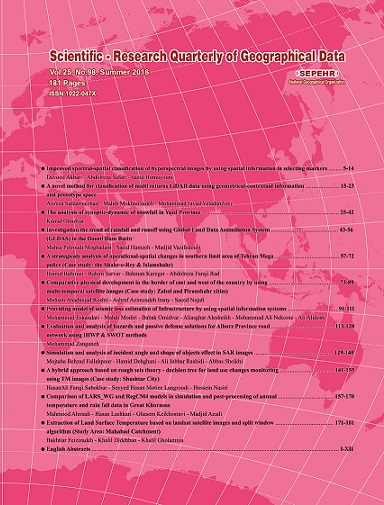Document Type : Research Paper
Authors
1 Assistant professor of agriculture engineering, Shahre - Kourd University
2 M.S Student of water resources- Water engineering department, Agricultural faculty Tehran University
Abstract
Introduction
Climate change will affect the availability of water resources and the sustainability of their management. The impact of climate change on water resources has caused concerns and serious challenges around the world. Global climate change has decreased water resources in many regions and especially in arid and semiarid regions such as Iran. Water shortages decrease both agricultural production and food security and can also limit the economic development and ecosystem health. There is also growing evidence that climate change is changing the hydrological cycle.
The province of Chaharmahal-o-Bakhtiariis the main supplier of water for Khuzestan and Isfahan provinces and inter-basin water transfer talks have always been going on for these two provinces. However, there has not been a comprehensive study on the discharge changes in the rivers of this province, nevertheless, we cannot judge the future of water transfer. In Iran, there have been several studies on the seasonal changes in precipitation and other climatic variables, but assessments of river flows are limited. Therefore, the purpose of this research is to document statistically significant trends in seasonal and annual changes in stream flow in the main rivers in Chaharmahal-o-Bakhtiari.
Materialsand Methods
The total monthly and seasonal streamflow time series for the period of 1358–1389 (32 years) corresponding to 12 hydrometric stations across the Chaharmahal-o- Bakhtiari province were obtained from the Chaharmahal-o-Bakhtiari Regional Water Organization. This study is done with the latest data (1389) published by Chaharmahal-o-Bakhtiari Regional Water Organization. At first, the linear trends are determined on annual and seasonal timescales using Mann–Kendall (MK) non-parametric trend tests.The non-parametric Mann-Kendall tests are based on the calculation of Kendall's tau between two samples which is itself based on the ranks with the samples. This test has been widely used to detect trends in series of environmental data, climatic data or hydrological data, because it is less sensitive to the non-normality of the distribution and less affected by extreme values or outliers in the series.Also, the magnitude of trend- if a linear trend is present in a time series- is estimated by using the non-parametric Sen’ estimator test. The Sen’ estimator method is commonly used for calculating the trend slope. Thus, in this study this method is also used to calculate the trend slopes to obtain the extent of trend changes.
A number of methods can be applied to determine change points of a time series. In this study, the change point in the stream flow time series in 12 studied hydrometric stations is identified by Pettitt’s test. This test is a non-parametric approach for detecting change points based on the mann-whitney test. It has been demonstrated that the Pettitt’s test is a useful technique for examining the occurrence of abrupt changes in climatic records.
Results andDiscussion
The results of the non-parametric Mann-Kendall tests (MK) for all studied rivers through the Chaharmahal-o-Bakhtiari province showed a decreasing trend in the stream flow in all 12 hydrometric stations for both seasonal and annual scale. The amount of reduction based on the Sen’ estimator method, varies at different stations and seasons, from 0.8 m3/s to 17 m3/s in Gordbisheh and Beheshtabad, respectively. On seasonal scale, the results indicate a significant reduction in stream flow of all stations in summer, while in winter-except at two stations (Deh- Cheshmh and Soulegan) significant trend was not observed. The results of Pettitt's test also suggest that, the abrupt downward change (statistically significant) in most studied stations occured in the early 1370s. On the other words, in two recent decades a significant decreasing trend in stream flow has occurred in Karoon and Zayandeh Rood Basin. The results also showed that, in addition to the mean of stream flow, the extreme values of stream flow in these rivers also experience a very sharp decrease during the studied period.
Conclusion
Decreasing trend in all studied hydrometric stations through the Chaharmahal-o-Bakhtiari province clearly shows the reduction of water resources in this province and also the reduction of the role of the province in water supply to the country. The abrupt downward change that occurred in the early 1370s in most studied hydrometric stations also shows that the reduction of water production in the province has started from about 20 years ago. Therefore, for any water transfer plan from this province to other regions, the practical principles should be considered. Another important issue that must be considered is that, the water resources in Chaharmahal-o- Bakhtiari province are sharply decreasing and the water plants should not be based on the old information.
Keywords

